Week 308: Data on Places of Worship, Next-Gen Hindu narratives, Aesthetic
Modern Hindu Content - 11/09/2025
Welcome to Eternal Path! This week we feature: data on places of worship, the narratives shaping next generation Hindus, and an aesthetic!
Religion Highlight: Places of Worship Between Religions
This chart of places of worship per capita comparing religions in the United States and India is interesting because it shows just how few Hindu temples there are in both countries, relative to the Hindu populations. It also highlights an interesting truth, borne out by land records. In India today, the three biggest landowners are: The Government of India, the Catholic Church (Christian), and the Waqf Boards (Muslim). The latter two groups benefited considerably from British and Islamic colonialism respectively.
More insight into the data used available here.
Diaspora Highlight: The Narratives Shaping Next Generation Hindus
As new generations of Hindu Americans are born in the United States, the Hindu community will have to reckon with how Hinduism is practices and transmitted across generations. More to come in the coming weeks on this topic. The first essay we highly encourage everyone to read is by Professor Vamsee Juluri and author C. Ragothama Rao titled “Creating a new ‘Mamdania’: Without their narrative, Hindu Americans have no future” - and available at: https://www.firstpost.com/opinion/creating-new-mamdania-hindu-americans-future-cultural-identity-13948914.html
One of the most interesting parts of the piece is the paragraph below. It talks about the abject failure of Hindu educational programs to equip Hindu children to refute anti-Hindu political tropes, leading to many Hindu children to graduate from temple and religious programs to become Hinduphobes themselves!
“A Hindu student activist recently commented that many of the South Asian student activist groups on their campus who frequently rally against Hindutva, Modi, Israel, and so on, happen to have been dutiful weekend Bal Vihar/Bal Vikas-type children themselves.”
Unsurprisingly, as a college professor, Juluri recommends that more Hindus get familiar with some the intellectual philosophers whose work can help Hindus equip themselves with the rhetorical and philosophical tools to defend their worldview and practice in an intellectual way.
“While many better-informed Hindus in America are now aware of the work of Vishwa Adluri and Joydeep Bagchee (the trope of the Brahmin, or greedy priest, as a “caricature of a rabbi drawn in brown chalk”, for instance), S N Balagangadhara, Prakash Shah, D Venkat Rao and other humanities and social science scholars in professional academia, and know that many things modern Hindu gurus and politicians and parents and volunteer teachers parrot are actually flawed, untruthful propaganda tropes, the damage continues to be done, weekend and after weekend.”
The latter part of that paragraph shows that there is more work to do. We at Eternal Path are forged from that fire of being not educated by our temples and community organization, and of being forced to answer directly to Hinduphobic tropes thrown at us in popular discourse and the educational system. Remember that the back issues of this blog are a treasure trove for narratives, thinking, and information that can help the Hindu community progress in its jnana yoga (the quest for knowledge) and its quest for building sangathan (community) - and we encourage you to step into the archives here https://eternalpath.substack.com/archive
We also encourage all our readers to fully read and inculcate learnings from the Juluri-Rao piece, and to send it around widely. Available at: https://www.firstpost.com/opinion/creating-new-mamdania-hindu-americans-future-cultural-identity-13948914.html

